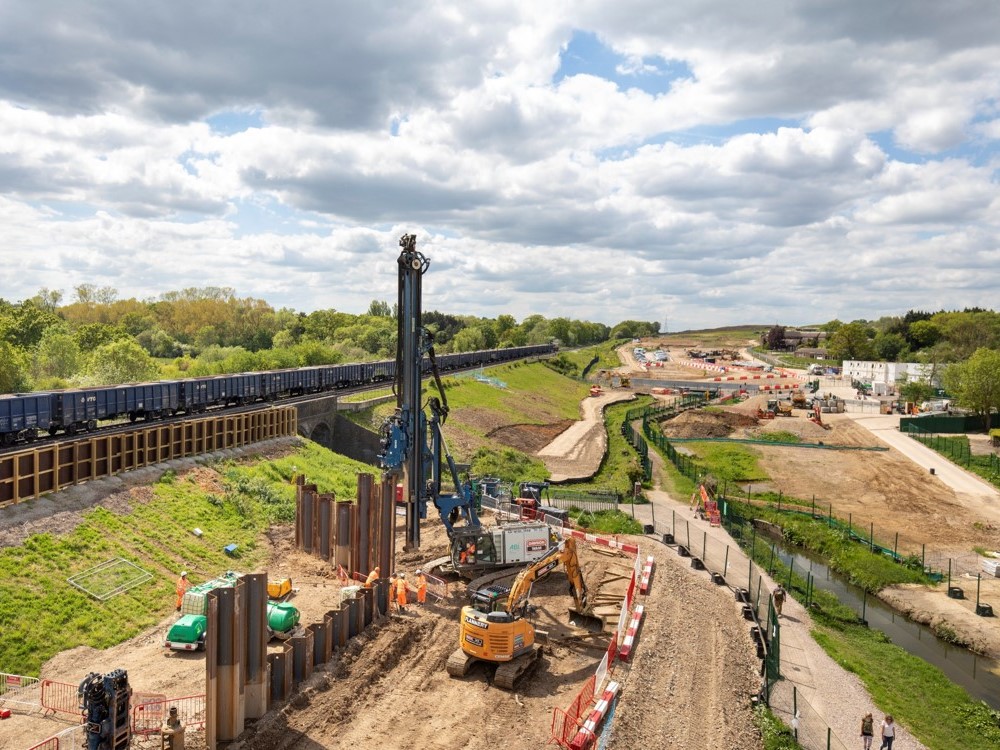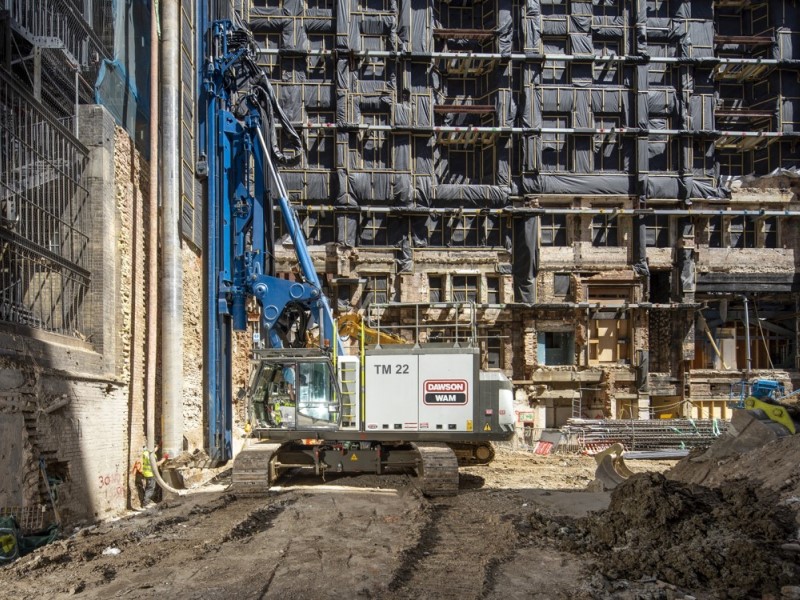London: HS2 Lots S1 & S2 – West Ruislip
PROJECT DETAILS
CLIENT:
HS2
DESIGN ENGINEER:
Design House JV (Arup-TYPSA-Strabag)
MAIN CONTRACTOR:
SCS Railways JV (Skanska-Costain-Strabag)
LOCATION:
West London
DAWSON-WAM was contracted by SCS Railways in a retaining wall package to provide all sheet piling works on the HS2 Lots S1 & S2 site at West Ruislip. This area of site sees the new HS2 line emerge from the London Tunnel System and become an overground section.
Sheet piles were to be installed in areas were significant retained heights were required in limited working areas.
The works were contracted to DAWSON-WAM after a competitive tender process and evaluated on commercial value and quality offering with the contract being NEC 3 Option A.
The initial works was relatively small in scale, valued at £860,000 however with significant collaboration on complex time critical solutions and substantial value engineering realisation by the SCS and DW teams additional works was added to the contract taking the overall value of the works to over £7,000,000.
The works took place immediately adjacent to busy Network Rail lines, in an area of environmental significance, adjacent to abundant wildlife and a rich watercourse, and next to a large residential population.
DAWSON-WAM delivered the works using digital planning and data capture tools, and 3D rehearsals of works were produced and integrated into the clients software for risk management and a right first time approach. 3D drawings and sequences were formed in an iterative process and used to disseminate information in a visual manner to workforce and interested parties.
Working space on site was at a premium and DAWSON-WAM worked collaboratively with rotary bored piling contractor Cementation Skanska to deliver the works safely and on time. Examples of collaboration were the sharing of commonly required but seldom used ancillary equipment such a MEWPs and air compressors. This collaboration allowed more working room for each subcontractor and reducing costs of equipment on site.
Sheet piles were delivered to site in a just in time basis throughout this project. Piles were ordered from supplier as per design and delivered to DAWSON-WAM’s 13 acre Bedfordshire yard where they were stored until required. Having the benefit of a storage facility allowed for a greater control over sheet piles and benefited the collaborative design approach which was taken throughout the scheme in order to save costs and mitigate material wastage.
The works on site were programme critical and as a result DAWSON-WAM utilised two of their powerful ABI TM22 piling rigs to complete the works. The use of two rigs with interchangeable attachments allowed for increase production as well as mitigating any risk of breakdowns.
These rigs are multi function with a range of attachments which can be quickly and safely changed over using the automatic quick docking system.
The rigs on this site used a variety of technics to install the piles including;
- preaugering with an advanced Cased CFA System
- Vibro driving with powerful 36VV vibro hammer (the most powerful leader rig mounted vibro in the UK and Europe)
- HydroPress system for silent and vibration free installation of piles
- Rig mounted impact hammer
Despite all the 3D rehearsals and planning of the works ground conditions can often change without warning. This was the case in a Network Rail embankment are where the site team discovered that the toe of the embankment was reinforced with large limestone boulders of 1m diameter over a 50m section were a sheet piled retaining wall was to be installed. This was contray to the information received from Network Rail and required some quick collaborative thinking by the site team. As the boulders could not be removed due to the stability of the embankment and the design approvals and programme constraints excluded a redesign, DW proposed an innovative rotary bored preauger technique which ultimately proved successful allowing the wall to be completed on time. A steel guide was fixed to the ground and 880mm rotary techniques were used to bore through the boulders and holes filled with pile-able material prior to the installation of the sheet piled retaining wall.
Harvil Road 26.25m Sheet Piles
One of the most onerous requirements on the additional works given to DAWSON-WAM was the requirement to install a 100m long sheet pile wall using 26.25m long AZ46-700s.
DAWSON-WAM own and operate an RTG RG27S, the largest sheet piling leader rig in the UK and capable of installing sheet piles up to 27m so was ideal for this requirement.
The pile line was preaugered with a 750mm diameter CFA prior to pitching and vibro driving by the RG27S. Sheet piles were driven to level using a impact hammer. In a noise sensitive area the largest Giken in the UK was used to press the piles to level with all piles reaching design toe levels to allow a 5.5m excavation.
Chiltern Line Night Time Possession Works
Another element of works was the installation of sheet piles to allow the construction of a new overbridge. The sheet piles being less than 3m from the rail lines were required to be complete in night time possessions. Due to the importance of the track to Network Rail working windows of 3.5hrs per night were permitted. DAWSON-WAM successfully installed 130lm of sheet piles in two visits (each side of the line) in 8 nights, and sheet piles were installed to design depth using a silent and vibration free Hydro Press rig attachment.
Attenuation Tank
An ancillary requirement which the company undertook on the scheme was the construction of a 4.5m deep attenuation tank.
Sheet piles were firstly installed around the perimeter and an external ring beam with ties cast to provide an external propping action.
A reinforce concrete base and baffle walls were cast and DW completed all the connections to existing drainage systems.
The tanks demonstrates the companies capacity to take on other works other than retaining walls.
3D Design and Digital Rehearsal
DAWSON-WAM utilised the latest design technology to produce 3D models of our equipment and working areas. These models were used to plan and risk assess works in an iterative manner. Final solution drawings and sequence models were then used to inform the workforce and other interested parties on the works, highlighting risk, to achieve a right first time approach.
These detailed models as well as well as data captured as works progressed were added to a collaborative digitial model owned by the client for the future planning, risk management and ultimately a digital as built model of the works.



